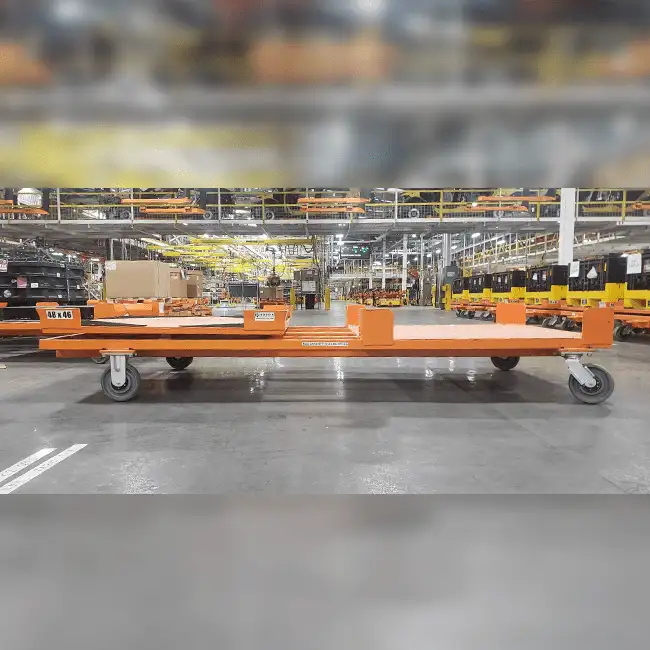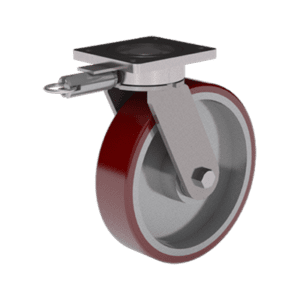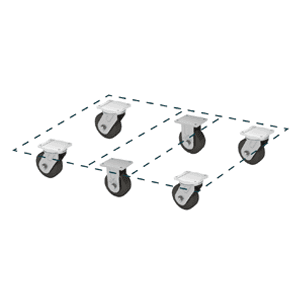

In my experience, fishtailing around corners can also be described by many different names but all point to a similar issue with carts that get tugged. When I say tugged, this can mean that you are pulling a single cart behind a tugger or that you have a mother/daughter (parent/child) cart set up and could have as many as 5-6 carts tugging behind a single tugger. I have found this to be an issue regardless of the length of the trailer(s) behind it.
When a tugger is weaving in and out through an assembly line or manufacturing facility, you can quickly see how important space is. Typically, aisle ways will only be wide enough for two-way traffic. Given a scenario where tuggers are heading in opposite directions simultaneously on the same aisle, you would not even have room to walk alongside as space is so tight. Generally, a walkway is painted on the ground for safety reasons, but you would not be comfortable walking in that spot given the above scenario.
Why would I draw out the scenario you just read? I wanted to help you understand what and how fishtailing carts could affect you — If not now, then in the future. Fishtailing around corners is the act of the cart not tracking behind a tugger as you would intend it to. In my experience, I have come across numerous occasions where we hear about the final cart swinging around and either:
1.) Hitting something (whether this be a worker, a piece of machinery, or a railing)
2.) Damaging the material on the cart, or
3.) Causing the cart to tip over, causing damage to the cart itself and the material on the cart. I have heard this cart movement be referred to either as “not tracking correctly,” “getting squirely behind the tugger,” “the cart gets a mind of its own, ” or the comment that “the cart is swinging all over the place when we turn.” Regardless of the comments, they all point to the same issue.
I hate to make assumptions, but if you are running into this issue, I am guessing you are in one of two boats. You are either using a cart that has four swivel casters on each corner, or you are using a tilt cart setup where you have four swivel casters around the corners of the cart and a set of rigid casters that are slightly taller in the center, allowing for the cart to tilt back and forth as needed.
The first fix I suggest is to check out the swivel casters you are currently using and identify if they are notched around the yoke of the swivel section. (If you are unsure what that means, please look at this video to better help you. Can I add Swivel Locks to a caster I already have? | Caster Concepts – YouTube).

Swivel Lock
If you do have notches in the swivel caster, I would recommend adding swivel locks to the casters that are furthest away from the tugger or the casters that are at the back of the cart while tugging. This will require an operator to bend down and engage the swivel lock, but it would then act as a rigid caster and allow your cart to track behind the tugger better.

Tilt configuration
Another option is to replace the casters on one side of the cart and use rigid casters so you do not have to worry about engaging/unengaging a swivel lock during the day. With a tilt-style setup, you should check the hitch/receiver connection first. Your issue could have more to do with that connection than the casters themselves. If that connection is loose or sloppy, you might have the cart bounce back and forth between which set of swivel casters are tracking on the ground. If you allow the back set of swivel casters to stay on the ground, you will find the cart fishtails all around. The other option would be adding a swivel lock to the back set of casters to help lock them into a fixed position. That way, the cart won’t move around unexpectedly.
If the operator can’t bend down and engage the swivel lock, reach out to your Caster Concepts rep, and they can help you determine what swivel locking system might be best to get around that. I have worked with customers on a foot-engaged swivel locking system that will lock both swivel casters with the kick of a foot pedal. This is just one example of accommodations that can be met to make life easier for you and your team.